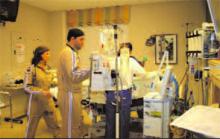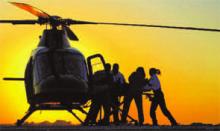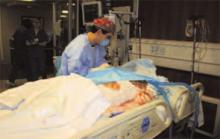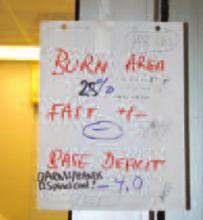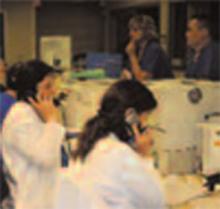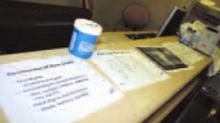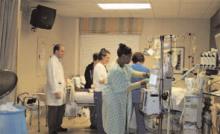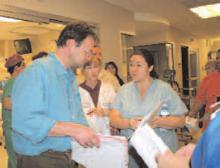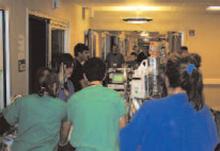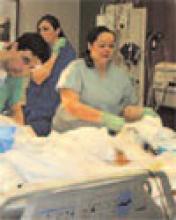User login
A Defining Night
It was just before 7:30 p.m. Feb. 7 when a huge explosion in the small Georgia town of Port Wentworth shook the community to its core.
It proved to be a night no one would soon forget. It also tested the young hospitalist program at Memorial University Medical Center (MUMC) in Savannah, a few miles from Port Wentworth.
At least 12 people were killed and more than 40 seriously or critically injured in the blast at the Imperial Sugar Refinery, better known to locals as the Dixie Crystal Sugar Refinery, a Savannah-area landmark for more than 100 years.
The Place to Go
MUMC is an academic medical center with a Level 1 trauma center that serves a 35-county area in southeast Georgia and southern South Carolina. It is often said that if a patient is in a serious accident, MUMC is the place to go.
We started a hospitalist program at MUMC in September 2006, with three hospitalists and an average census of four patients. We now have seven hospitalists, expanding to 10 in July, and an average census of 65. Though still a fledgling department, we grew a lot the night of Feb. 7 and played a significant role in helping disaster victims. Immediate response, flexibility, and focus were paramount in defining our reaction to the crisis. Here’s how events unfolded that difficult night:
7:30 p.m.
We got the call and mobilized all five hospitalists in the emergency department (ED) 20 minutes later. It was organized chaos as trauma surgeons and ED physicians attended to the rapidly increasing number of victims arriving by ambulance and helicopter. Before the blast, the ED waiting room was packed with about 45 patients who needed attention.
8:15 p.m.
Many victims suffered serious burns from the explosion. Burn specialists from the Joseph M. Still Burn Center in Augusta arrived by helicopter. Space in the ED became desperately crowded with the seemingly endless number of victims, so we were all busily tending to the existing ED patients in every capacity possible to try and get them out of the ED. We sutured wounds, started and removed IVs, treated pregnant patients, triaged every medical patient, transported patients, and did whatever else was required. In about 90 minutes we had essentially cleared the entire ED. At this point, some of the trauma victims were moved upstairs to the intensive care unit (ICU).
9 p.m.
Victims were still arriving with burns over 40% to 80% of their bodies. After we’d cleared the ED as much as possible to make room for new patients, we focused on the immediate need for medical-surgical beds. MUMC was almost at capacity before the explosion, and suddenly a large number of patients were being emergently triaged out of the ICUs to make way for the burn victims.
The teamwork throughout the hospital was amazing to watch. From the ED to the medical floor, everyone worked together with precision as if this happened every day. Several patients were held in the ICU awaiting helicopter fight to the Augusta Burn Center; extra staff were assigned to those patients. Patient-care technicians began taking water and blankets to family members who had arrived at the hospital.
Our team began leading a massive effort to discharge and transfer noncritical patients from the medical floors. We called our coordinator Deborah Haywood, RN, BSN, who was at central command and told her we could use some of the nurses and case managers who were showing up to offer help. We took our census and identified patients who could possibly be discharged. We turned on televisions in patients’ rooms to show and explain to patients what was happening with the explosion. With the aid of arriving nurses we arranged discharge, follow-up, and transportation for every patient who could leave.
9:45 p.m.
Victims stopped arriving at the hospital. As the first of our patients from the floors began to leave, the internal medicine and family medicine residents came to offer help. We quickly went through the census and helped them figure out which patients could be discharged.
Amazingly, our coordinator located and directed case managers, psychiatric nurse managers, and intake personnel to us. They paired with the residents to help them transfer and discharge patients. We were fortunate that some of the smaller community hospitals opened their doors and accepted some of the less-critical patients in transfer.
10:30 p.m.
Several burn victims received emergent escharotomies. Helicopters transported the most severely burned to the Augusta burn center. Patients transferred from the ICU and holding areas around the ED began to occupy the medical-surgical beds we had created.
Clearly we needed more beds. We went back, reviewed the census on each floor, and found more patients willing and able to leave. Within two hours we discharged 22 patients. Our coordinator took their names, and patient relations called to ensure proper follow-up and thanks to the patients for helping in a time of crisis.
12:45 a.m.
When we finally got together and looked at the clock it was 12:45 a.m. The ED was clear and beds were available. Staff started to go home. Many of us had been working with minimal break time since 7 a.m.
We either went home or found a call room to rest in because we all knew the next day would be a long one. It had been a swift and busy night, but the true journey for the victims and our community had really just begun.
It was with tremendous sadness that we watched this event unfold on local and national news. None of us knew the extent of the damage done at the plant, and it was difficult to comprehend and empathize with what the victims had just suffered. Several victims were in such pain and emotional shock that it took them several days to describe to us what had happened.
It was also with a heightened sense of purpose that we went to work after this disaster. MUMC staff should be proud of the work, coordination, and precision with which such a large number of people came together and saved lives. The trauma teams, ED, and ICU staff, and countless others from every department at MUMC along with staff from the Joseph M. Still Burn Center in Augusta demonstrated competence and coordination.
As a group, MUMC Hospitalists played an important role, helping people in their hour of need. We believed in our team and our hospital’s ability to respond to an unforeseen crisis. We had defined our role instantly and spontaneously. We took a leadership position in a much-needed, albeit not so obvious, area.
We appreciated the fact that our relatively young hospitalist program was recognized for its contribution that night. We were part of the hospital’s debriefing and have become an integral part of the institution’s official disaster team.
While we certainly hope never to have to respond to such a devastating situation again, we know we are an important part of the team—and that our dedication and commitment will allow us to rise to any occasion. TH
The authors are members of Memorial Health Hospitalists, the hospitalist program at Memorial University Medical Center in Savannah, Ga.
It was just before 7:30 p.m. Feb. 7 when a huge explosion in the small Georgia town of Port Wentworth shook the community to its core.
It proved to be a night no one would soon forget. It also tested the young hospitalist program at Memorial University Medical Center (MUMC) in Savannah, a few miles from Port Wentworth.
At least 12 people were killed and more than 40 seriously or critically injured in the blast at the Imperial Sugar Refinery, better known to locals as the Dixie Crystal Sugar Refinery, a Savannah-area landmark for more than 100 years.
The Place to Go
MUMC is an academic medical center with a Level 1 trauma center that serves a 35-county area in southeast Georgia and southern South Carolina. It is often said that if a patient is in a serious accident, MUMC is the place to go.
We started a hospitalist program at MUMC in September 2006, with three hospitalists and an average census of four patients. We now have seven hospitalists, expanding to 10 in July, and an average census of 65. Though still a fledgling department, we grew a lot the night of Feb. 7 and played a significant role in helping disaster victims. Immediate response, flexibility, and focus were paramount in defining our reaction to the crisis. Here’s how events unfolded that difficult night:
7:30 p.m.
We got the call and mobilized all five hospitalists in the emergency department (ED) 20 minutes later. It was organized chaos as trauma surgeons and ED physicians attended to the rapidly increasing number of victims arriving by ambulance and helicopter. Before the blast, the ED waiting room was packed with about 45 patients who needed attention.
8:15 p.m.
Many victims suffered serious burns from the explosion. Burn specialists from the Joseph M. Still Burn Center in Augusta arrived by helicopter. Space in the ED became desperately crowded with the seemingly endless number of victims, so we were all busily tending to the existing ED patients in every capacity possible to try and get them out of the ED. We sutured wounds, started and removed IVs, treated pregnant patients, triaged every medical patient, transported patients, and did whatever else was required. In about 90 minutes we had essentially cleared the entire ED. At this point, some of the trauma victims were moved upstairs to the intensive care unit (ICU).
9 p.m.
Victims were still arriving with burns over 40% to 80% of their bodies. After we’d cleared the ED as much as possible to make room for new patients, we focused on the immediate need for medical-surgical beds. MUMC was almost at capacity before the explosion, and suddenly a large number of patients were being emergently triaged out of the ICUs to make way for the burn victims.
The teamwork throughout the hospital was amazing to watch. From the ED to the medical floor, everyone worked together with precision as if this happened every day. Several patients were held in the ICU awaiting helicopter fight to the Augusta Burn Center; extra staff were assigned to those patients. Patient-care technicians began taking water and blankets to family members who had arrived at the hospital.
Our team began leading a massive effort to discharge and transfer noncritical patients from the medical floors. We called our coordinator Deborah Haywood, RN, BSN, who was at central command and told her we could use some of the nurses and case managers who were showing up to offer help. We took our census and identified patients who could possibly be discharged. We turned on televisions in patients’ rooms to show and explain to patients what was happening with the explosion. With the aid of arriving nurses we arranged discharge, follow-up, and transportation for every patient who could leave.
9:45 p.m.
Victims stopped arriving at the hospital. As the first of our patients from the floors began to leave, the internal medicine and family medicine residents came to offer help. We quickly went through the census and helped them figure out which patients could be discharged.
Amazingly, our coordinator located and directed case managers, psychiatric nurse managers, and intake personnel to us. They paired with the residents to help them transfer and discharge patients. We were fortunate that some of the smaller community hospitals opened their doors and accepted some of the less-critical patients in transfer.
10:30 p.m.
Several burn victims received emergent escharotomies. Helicopters transported the most severely burned to the Augusta burn center. Patients transferred from the ICU and holding areas around the ED began to occupy the medical-surgical beds we had created.
Clearly we needed more beds. We went back, reviewed the census on each floor, and found more patients willing and able to leave. Within two hours we discharged 22 patients. Our coordinator took their names, and patient relations called to ensure proper follow-up and thanks to the patients for helping in a time of crisis.
12:45 a.m.
When we finally got together and looked at the clock it was 12:45 a.m. The ED was clear and beds were available. Staff started to go home. Many of us had been working with minimal break time since 7 a.m.
We either went home or found a call room to rest in because we all knew the next day would be a long one. It had been a swift and busy night, but the true journey for the victims and our community had really just begun.
It was with tremendous sadness that we watched this event unfold on local and national news. None of us knew the extent of the damage done at the plant, and it was difficult to comprehend and empathize with what the victims had just suffered. Several victims were in such pain and emotional shock that it took them several days to describe to us what had happened.
It was also with a heightened sense of purpose that we went to work after this disaster. MUMC staff should be proud of the work, coordination, and precision with which such a large number of people came together and saved lives. The trauma teams, ED, and ICU staff, and countless others from every department at MUMC along with staff from the Joseph M. Still Burn Center in Augusta demonstrated competence and coordination.
As a group, MUMC Hospitalists played an important role, helping people in their hour of need. We believed in our team and our hospital’s ability to respond to an unforeseen crisis. We had defined our role instantly and spontaneously. We took a leadership position in a much-needed, albeit not so obvious, area.
We appreciated the fact that our relatively young hospitalist program was recognized for its contribution that night. We were part of the hospital’s debriefing and have become an integral part of the institution’s official disaster team.
While we certainly hope never to have to respond to such a devastating situation again, we know we are an important part of the team—and that our dedication and commitment will allow us to rise to any occasion. TH
The authors are members of Memorial Health Hospitalists, the hospitalist program at Memorial University Medical Center in Savannah, Ga.
It was just before 7:30 p.m. Feb. 7 when a huge explosion in the small Georgia town of Port Wentworth shook the community to its core.
It proved to be a night no one would soon forget. It also tested the young hospitalist program at Memorial University Medical Center (MUMC) in Savannah, a few miles from Port Wentworth.
At least 12 people were killed and more than 40 seriously or critically injured in the blast at the Imperial Sugar Refinery, better known to locals as the Dixie Crystal Sugar Refinery, a Savannah-area landmark for more than 100 years.
The Place to Go
MUMC is an academic medical center with a Level 1 trauma center that serves a 35-county area in southeast Georgia and southern South Carolina. It is often said that if a patient is in a serious accident, MUMC is the place to go.
We started a hospitalist program at MUMC in September 2006, with three hospitalists and an average census of four patients. We now have seven hospitalists, expanding to 10 in July, and an average census of 65. Though still a fledgling department, we grew a lot the night of Feb. 7 and played a significant role in helping disaster victims. Immediate response, flexibility, and focus were paramount in defining our reaction to the crisis. Here’s how events unfolded that difficult night:
7:30 p.m.
We got the call and mobilized all five hospitalists in the emergency department (ED) 20 minutes later. It was organized chaos as trauma surgeons and ED physicians attended to the rapidly increasing number of victims arriving by ambulance and helicopter. Before the blast, the ED waiting room was packed with about 45 patients who needed attention.
8:15 p.m.
Many victims suffered serious burns from the explosion. Burn specialists from the Joseph M. Still Burn Center in Augusta arrived by helicopter. Space in the ED became desperately crowded with the seemingly endless number of victims, so we were all busily tending to the existing ED patients in every capacity possible to try and get them out of the ED. We sutured wounds, started and removed IVs, treated pregnant patients, triaged every medical patient, transported patients, and did whatever else was required. In about 90 minutes we had essentially cleared the entire ED. At this point, some of the trauma victims were moved upstairs to the intensive care unit (ICU).
9 p.m.
Victims were still arriving with burns over 40% to 80% of their bodies. After we’d cleared the ED as much as possible to make room for new patients, we focused on the immediate need for medical-surgical beds. MUMC was almost at capacity before the explosion, and suddenly a large number of patients were being emergently triaged out of the ICUs to make way for the burn victims.
The teamwork throughout the hospital was amazing to watch. From the ED to the medical floor, everyone worked together with precision as if this happened every day. Several patients were held in the ICU awaiting helicopter fight to the Augusta Burn Center; extra staff were assigned to those patients. Patient-care technicians began taking water and blankets to family members who had arrived at the hospital.
Our team began leading a massive effort to discharge and transfer noncritical patients from the medical floors. We called our coordinator Deborah Haywood, RN, BSN, who was at central command and told her we could use some of the nurses and case managers who were showing up to offer help. We took our census and identified patients who could possibly be discharged. We turned on televisions in patients’ rooms to show and explain to patients what was happening with the explosion. With the aid of arriving nurses we arranged discharge, follow-up, and transportation for every patient who could leave.
9:45 p.m.
Victims stopped arriving at the hospital. As the first of our patients from the floors began to leave, the internal medicine and family medicine residents came to offer help. We quickly went through the census and helped them figure out which patients could be discharged.
Amazingly, our coordinator located and directed case managers, psychiatric nurse managers, and intake personnel to us. They paired with the residents to help them transfer and discharge patients. We were fortunate that some of the smaller community hospitals opened their doors and accepted some of the less-critical patients in transfer.
10:30 p.m.
Several burn victims received emergent escharotomies. Helicopters transported the most severely burned to the Augusta burn center. Patients transferred from the ICU and holding areas around the ED began to occupy the medical-surgical beds we had created.
Clearly we needed more beds. We went back, reviewed the census on each floor, and found more patients willing and able to leave. Within two hours we discharged 22 patients. Our coordinator took their names, and patient relations called to ensure proper follow-up and thanks to the patients for helping in a time of crisis.
12:45 a.m.
When we finally got together and looked at the clock it was 12:45 a.m. The ED was clear and beds were available. Staff started to go home. Many of us had been working with minimal break time since 7 a.m.
We either went home or found a call room to rest in because we all knew the next day would be a long one. It had been a swift and busy night, but the true journey for the victims and our community had really just begun.
It was with tremendous sadness that we watched this event unfold on local and national news. None of us knew the extent of the damage done at the plant, and it was difficult to comprehend and empathize with what the victims had just suffered. Several victims were in such pain and emotional shock that it took them several days to describe to us what had happened.
It was also with a heightened sense of purpose that we went to work after this disaster. MUMC staff should be proud of the work, coordination, and precision with which such a large number of people came together and saved lives. The trauma teams, ED, and ICU staff, and countless others from every department at MUMC along with staff from the Joseph M. Still Burn Center in Augusta demonstrated competence and coordination.
As a group, MUMC Hospitalists played an important role, helping people in their hour of need. We believed in our team and our hospital’s ability to respond to an unforeseen crisis. We had defined our role instantly and spontaneously. We took a leadership position in a much-needed, albeit not so obvious, area.
We appreciated the fact that our relatively young hospitalist program was recognized for its contribution that night. We were part of the hospital’s debriefing and have become an integral part of the institution’s official disaster team.
While we certainly hope never to have to respond to such a devastating situation again, we know we are an important part of the team—and that our dedication and commitment will allow us to rise to any occasion. TH
The authors are members of Memorial Health Hospitalists, the hospitalist program at Memorial University Medical Center in Savannah, Ga.
